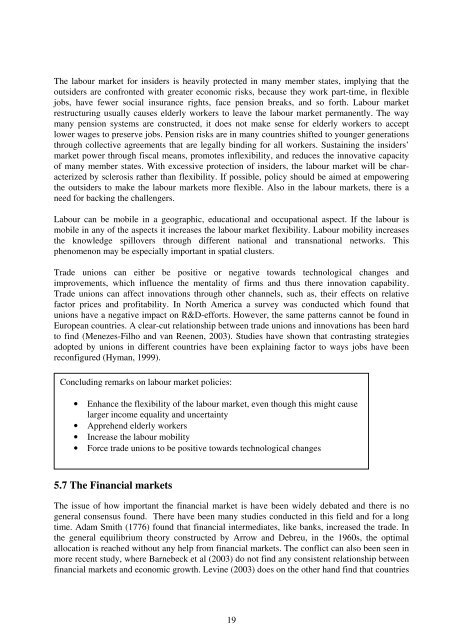INNOVATION POLICY INSTRUMENTS
INNOVATION POLICY INSTRUMENTS
INNOVATION POLICY INSTRUMENTS
Create successful ePaper yourself
Turn your PDF publications into a flip-book with our unique Google optimized e-Paper software.
The labour market for insiders is heavily protected in many member states, implying that the<br />
outsiders are confronted with greater economic risks, because they work part-time, in flexible<br />
jobs, have fewer social insurance rights, face pension breaks, and so forth. Labour market<br />
restructuring usually causes elderly workers to leave the labour market permanently. The way<br />
many pension systems are constructed, it does not make sense for elderly workers to accept<br />
lower wages to preserve jobs. Pension risks are in many countries shifted to younger generations<br />
through collective agreements that are legally binding for all workers. Sustaining the insiders’<br />
market power through fiscal means, promotes inflexibility, and reduces the innovative capacity<br />
of many member states. With excessive protection of insiders, the labour market will be characterized<br />
by sclerosis rather than flexibility. If possible, policy should be aimed at empowering<br />
the outsiders to make the labour markets more flexible. Also in the labour markets, there is a<br />
need for backing the challengers.<br />
Labour can be mobile in a geographic, educational and occupational aspect. If the labour is<br />
mobile in any of the aspects it increases the labour market flexibility. Labour mobility increases<br />
the knowledge spillovers through different national and transnational networks. This<br />
phenomenon may be especially important in spatial clusters.<br />
Trade unions can either be positive or negative towards technological changes and<br />
improvements, which influence the mentality of firms and thus there innovation capability.<br />
Trade unions can affect innovations through other channels, such as, their effects on relative<br />
factor prices and profitability. In North America a survey was conducted which found that<br />
unions have a negative impact on R&D-efforts. However, the same patterns cannot be found in<br />
European countries. A clear-cut relationship between trade unions and innovations has been hard<br />
to find (Menezes-Filho and van Reenen, 2003). Studies have shown that contrasting strategies<br />
adopted by unions in different countries have been explaining factor to ways jobs have been<br />
reconfigured (Hyman, 1999).<br />
Concluding remarks on labour market policies:<br />
• Enhance the flexibility of the labour market, even though this might cause<br />
larger income equality and uncertainty<br />
• Apprehend elderly workers<br />
• Increase the labour mobility<br />
• Force trade unions to be positive towards technological changes<br />
5.7 The Financial markets<br />
The issue of how important the financial market is have been widely debated and there is no<br />
general consensus found. There have been many studies conducted in this field and for a long<br />
time. Adam Smith (1776) found that financial intermediates, like banks, increased the trade. In<br />
the general equilibrium theory constructed by Arrow and Debreu, in the 1960s, the optimal<br />
allocation is reached without any help from financial markets. The conflict can also been seen in<br />
more recent study, where Barnebeck et al (2003) do not find any consistent relationship between<br />
financial markets and economic growth. Levine (2003) does on the other hand find that countries<br />
19
















